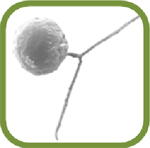Dunaliella Sampling, Isolation, Identification, Culture Maintenance and Analytical Methods
Demand for skills to isolate, cultivate, harvest and process the microalga Dunaliella for glycerol and β-carotene, protein and a range of other high value nutraceuticals is expected to increase for the following reasons:
Sustainability:
Natural populations of Dunaliella grow in non-potable, highly saline environments that typify the salt pans and desalination waters. Environments such as are found in the coastal regions of Namibia, Ghana and South Africa provide an opportunity for the development of new sustainable non-food biomass businesses and supply chains based on the cultivation of Dunaliella.
 Climate change and CO2 fixation:
Climate change and CO2 fixation:
Dunaliella fixes CO2 in photosynthesis: available estimates suggest 100 t of algae will fix ca.183 t CO2
β-carotene:
Dunaliella is currently cultivated commercially for β-carotene, the content of which vastly exceeds that found in many land plants. β-carotene accounts for about 10% of the dry cell weight. FDA approval for Dunaliella as a source of β-carotene was granted in 2008 (GRAS Notification Dunaliella Bardawil Food Usage Conditions for General Recognition of Safety Dec 2008 for NIKKEN SOHONSHA CORPORATION).
 Useful Dunaliella protocols
Useful Dunaliella protocols
Dunaliella analytical methods
- Glycerol determination and glycerol assay (courtesy A Ben-Amotz)
- Chlorophyll and carotenoids assay (courtesy A Ben-Amotz)
- Beta-Carotene assay (courtesy A Ben-Amotz)
- Phosphate assay (courtesy A Ben-Amotz)
- Total CO2 (courtesy A Ben-Amotz)